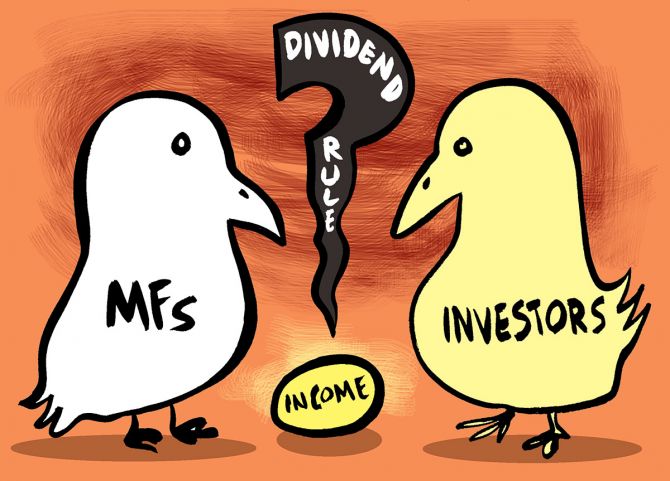Experts believe the new norms may be an indirect way for Sebi to apply the brakes on dividend option plans in MFs.
Ashley Coutinho reports.

The mutual fund industry has reached out to tax consultants and registrar and transfer agents to comply with the Securities and Exchange Board of India's dividend diktat that comes into effect from today, April 1.
The new norms require dividend doled out by fund houses to be segregated as income distribution (appreciation in net asset value, or NAV) and capital distribution (equalisation reserve) in the consolidated income statement.
The Association of Mutual Funds in India (Amfi) had written to Sebi, asking it to reconsider the proposal as it would be difficult for individual investors to implement at the investor level, and could lead to taxation issues.
Sebi, however, refused to budge, and asked the industry to work out a solution, said people in the know.
"We have consulted tax experts and been advised that capital distribution may be interpreted differently by tax authorities and pose challenges to investors. Fund houses will face compliance challenges as well in deducting tax at source, resulting in possible disputes with investors," said an industry official.
The person added that the segregation of income and capital distribution is done at the fund level in developed markets, too, and not at the investor level.
"The terminology proposed in the circular needs to be reviewed. The dividend plan should be called distribution plan, and the words 'capital' and 'income' should be replaced by 'equalisation' and 'realised gains', respectively, to ensure there are no adverse tax implications," said the official quoted above.
When a unit is sold, and the sale price (NAV) is higher than the face value of the unit, a portion of the sale price that represents realised gains has to be credited to an equalisation reserve account, which can be used to pay dividend, the new norms suggest.
Income distributed by MFs is taxable in the hands of investors and attracts TDS.
If MFs do not deduct TDS from the capital distributed among investors, the overall tax collection could fall, resulting in revenue loss for the government.
If MFs choose to deduct tax on the entire quantum of distribution, there may be a TDS mismatches for investors, if it transpires that there is no tax to be paid on the capital distribution portion of the dividend paid.
While income distributed is taxable in the hands of investors and subject to TDS, there is ambiguity with respect to the tax treatment of capital returned to investors.
There is also uncertainty on whether investors will be able to adjust the cost of acquisition of the units and avail of indexation benefits.
The segregation will be difficult in the case of exchange-traded funds as it is difficult to determine at what price investors traded the units.
For example, take the case of two investors A and B who enter an MF scheme when the NAV is Rs 10 and Rs 20, respectively.
Let's say the MF books profits and declares a dividend of Rs 5 when the NAV becomes Rs 22.
For A, the entire Rs 5 would be treated as income distribution as it relates to the increase in NAV.
For B, Rs 2 would be considered as income distribution and Rs 3 would become capital distribution.
At present, the entire Rs 5 is being considered as income.
But, this will change. In the above example, A may pay tax on Rs 5, while B may pay tax on Rs 2.
The second investor may deduct Rs 3 (capital distribution) from the NAV to arrive at the cost of acquisition.
Experts believe the new norms may be an indirect way for the regulator to apply the brakes on dividend option plans in MFs.
In the past, several hybrid schemes were mis-sold to investors with the promise of regular dividends.











